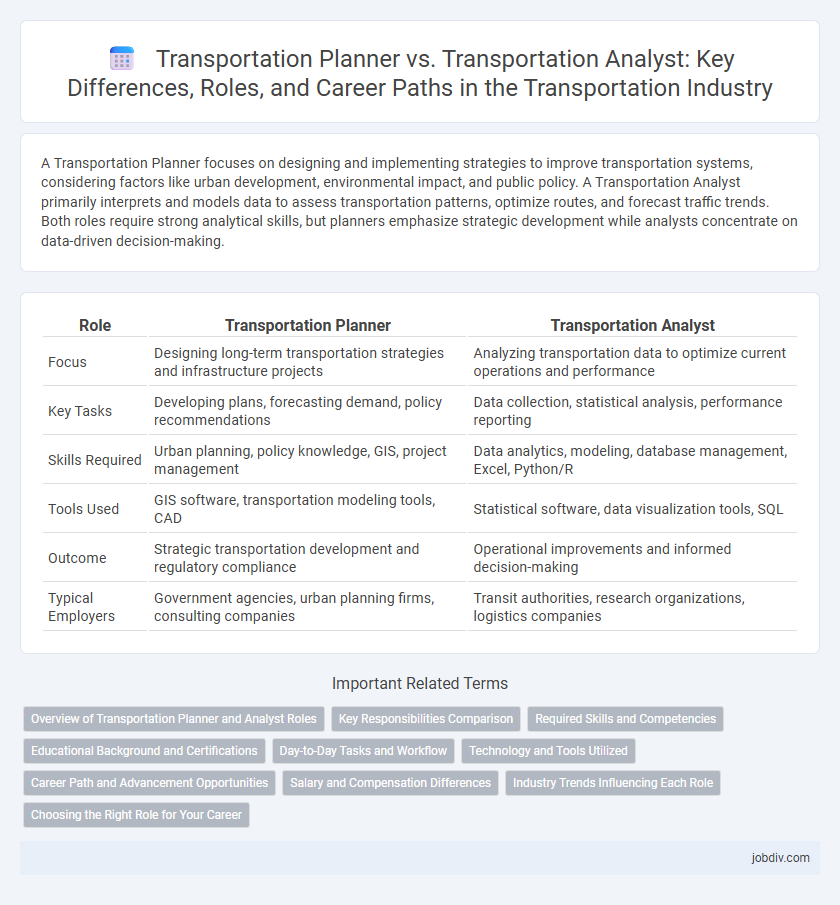A Transportation Planner focuses on designing and implementing strategies to improve transportation systems, considering factors like urban development, environmental impact, and public policy. A Transportation Analyst primarily interprets and models data to assess transportation patterns, optimize routes, and forecast traffic trends. Both roles require strong analytical skills, but planners emphasize strategic development while analysts concentrate on data-driven decision-making.
Table of Comparison
| Role | Transportation Planner | Transportation Analyst |
|---|---|---|
| Focus | Designing long-term transportation strategies and infrastructure projects | Analyzing transportation data to optimize current operations and performance |
| Key Tasks | Developing plans, forecasting demand, policy recommendations | Data collection, statistical analysis, performance reporting |
| Skills Required | Urban planning, policy knowledge, GIS, project management | Data analytics, modeling, database management, Excel, Python/R |
| Tools Used | GIS software, transportation modeling tools, CAD | Statistical software, data visualization tools, SQL |
| Outcome | Strategic transportation development and regulatory compliance | Operational improvements and informed decision-making |
| Typical Employers | Government agencies, urban planning firms, consulting companies | Transit authorities, research organizations, logistics companies |
Overview of Transportation Planner and Analyst Roles
Transportation Planners develop strategic plans to optimize transportation systems by analyzing land use, population growth, and infrastructure needs to improve mobility and reduce congestion. Transportation Analysts focus on collecting and interpreting data such as traffic flow, transit usage, and environmental impact to support decision-making and policy development. Both roles play crucial parts in ensuring efficient, sustainable transportation networks through complementary yet distinct responsibilities.
Key Responsibilities Comparison
Transportation planners develop long-term strategies for infrastructure projects, analyzing traffic patterns and land use to optimize urban mobility. Transportation analysts collect and interpret data such as traffic flow, ridership statistics, and environmental impact to support decision-making and improve operational efficiency. Both roles collaborate to enhance transportation systems but differ as planners focus on strategic design while analysts emphasize data-driven evaluation.
Required Skills and Competencies
Transportation Planners require strong skills in urban planning, GIS mapping, and stakeholder communication to develop efficient transit systems that align with regulatory policies. Transportation Analysts must possess advanced data analysis capabilities, proficiency in transportation modeling software, and a deep understanding of traffic flow patterns to evaluate system performance and forecast demand. Both roles benefit from competencies in project management, public policy interpretation, and critical thinking to optimize transportation networks.
Educational Background and Certifications
Transportation Planners typically hold a bachelor's or master's degree in urban planning, civil engineering, or transportation engineering, often supplemented with certifications such as the American Institute of Certified Planners (AICP). Transportation Analysts usually have degrees in economics, statistics, or data science, emphasizing quantitative skills, with certifications like Certified Transportation Planner (CTP) or data analysis credentials. Both roles value advanced education and professional certifications to enhance expertise in transportation system design, policy analysis, and data-driven decision-making.
Day-to-Day Tasks and Workflow
Transportation Planners develop strategic plans to improve transportation systems, focusing on long-term infrastructure projects, land use coordination, and policy recommendations. Transportation Analysts primarily handle data collection, traffic modeling, and performance analysis to support decision-making and optimize existing transportation operations. Both roles collaborate closely, with Planners shaping the vision while Analysts provide the quantitative insights essential for effective implementation.
Technology and Tools Utilized
Transportation planners primarily utilize geographic information systems (GIS), computer-aided design (CAD) software, and travel demand modeling tools to develop and optimize transportation networks. Transportation analysts focus on data analytics platforms, statistical software like R or Python, and traffic simulation models to evaluate transportation system performance and forecast trends. Both roles leverage advanced technologies such as big data analytics and machine learning to enhance decision-making and improve mobility solutions.
Career Path and Advancement Opportunities
Transportation Planners typically advance by moving into senior planning roles, project management, or policy advisory positions within government agencies or consulting firms, leveraging their expertise in long-term infrastructure development and urban planning. Transportation Analysts often progress by specializing in data analytics, modeling, or performance measurement, leading to roles such as senior analysts, data scientists, or transportation systems managers focused on optimizing operational efficiency. Both career paths offer opportunities for leadership roles in public transportation authorities, metropolitan planning organizations, or private sector transportation consulting firms, with advancement depending on technical skills, project experience, and strategic decision-making capabilities.
Salary and Compensation Differences
Transportation planners typically earn higher salaries than transportation analysts, with median annual wages around $75,000 compared to $60,000 for analysts, reflecting their broader responsibilities in project design and policy development. Benefits such as health insurance, retirement plans, and bonuses vary by employer but often align with government or private sector standards, with planners generally receiving more comprehensive compensation packages. Salary growth potential is stronger for transportation planners due to greater leadership roles and involvement in strategic planning, while analysts may have more specialized, technical career trajectories.
Industry Trends Influencing Each Role
Transportation planners prioritize long-term infrastructure development and policy-making driven by urbanization and sustainability trends, focusing on integrating multimodal transit solutions and reducing environmental impact. Transportation analysts use data analytics and geographic information systems (GIS) to optimize current operations, influenced by advancements in big data, machine learning, and real-time traffic monitoring technologies. Industry trends such as smart city initiatives and autonomous vehicle adoption increasingly blur the boundaries between these roles, demanding cross-disciplinary expertise.
Choosing the Right Role for Your Career
Transportation planners develop strategic plans to improve infrastructure and traffic flow, emphasizing urban growth and environmental impact. Transportation analysts focus on data collection, modeling, and performance metrics to optimize current systems and forecast future transportation needs. Selecting the right role depends on your interest in either long-term planning and policy development or data-driven analysis and operational efficiency.
Transportation Planner vs Transportation Analyst Infographic

 jobdiv.com
jobdiv.com